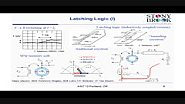Logic design
Logic Design
Logic Design refers to the basic organization of the circuit components in a digital computer. It forms an important part of embedded surfaces and involves designing components to work together and perform their logical functions.
A digital computer is built around a two-value logic system – true/false, yes/no, on/off, or 1/0. To perform computations, they rely on special components known as logic gates. These consist of integrated circuits, which receive input signals, process them, and convert them into outputs.
As a signal or clock pulse travels through these gates, they could either block it or allow it to pass. The output portion of the logic gates may either deliver the result of the operation or act as the input controls for other gates they may be connected to.
There are seven main types of logic designs that Integrated Circuits use to perform fundamental logical operations.
AND Gate
This logic gate gives a “true” output only when all inputs are “true.” If one or more inputs happen to be “false,” then this gate's output will also be “false.”
OR Gate
This logic gate gives a “true” output only when one or more inputs are “true.” If all inputs are “false,” then this gate's output will also be “false.”
NOT Gate
This logic gate has a single input and a single output. The latter performs an inverter operation on the input. If the input is “true,” then this gate's output will be “false.” Likewise, if the input is “false,” then the output will be “true.”
NAND Gate
This logic gate performs an AND operation on the inputs followed by a NOT. A NAND gate is effectively a combination of behavior of the AND and NOT gates. If this gate's inputs are all “true,” then the output will be “false.” Any other combination of inputs will always yield a “true” output.
NOR Gate
This logic gate performs an OR operation on the inputs followed by a NOT. It is effectively a combination of the behavior of an OR and a NOT gate. If any one of the inputs is “true,” then the output will always be “false.” It will only yield a “true” output when all inputs are “false.”
XOR Gate
The Exclusive-OR gate, or XOR, has two inputs and only one output. This gate's output will only be “true” when only one of the inputs is “true.” If the inputs are either both “true” or both “false,” then the output will always be “false.”
XNOR Gate
The Exclusive-NOR gate, or XNOR, has two inputs and only one output. The output of this gate will only be “true” if the inputs are either both “true” or both “false.” When only one of the inputs is “true,” the output will always be “false.”
Logic Design has several applications in modern-day circuitry. It is frequently used in:
- Automatic sprinkler systems
- Light-activated burglar alarms
- Locks with push-to-open or push-to-start buttons
- Safety thermostats
- Streetlights












